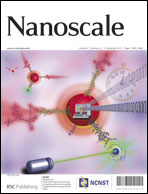Quantitative in situ TEM tensile fatigue testing on nanocrystalline metallic ultrathin films†
Abstract
A unique technique to perform quantitative in situ transmission electron microscopy (TEM) fatigue testing on ultrathin films and nanomaterials is demonstrated. The technique relies on a microelectromechanical system (MEMS) device to actuate a nanospecimen and measure its mechanical response. Compared to previously demonstrated MEMS-based in situ TEM techniques, the technique takes advantage of two identical capacitive sensors on each side of the specimen to measure electronically elongation (with nm resolution) and applied force (with μN resolution). Monotonic and fatigue tests were performed on nanocrystalline gold ultrathin film specimens that were manipulated and fixed onto the MEMS device without the use of a focused ion-beam microscope (and therefore, importantly, without any associated surface damage). The major advantage of the technique is its capability to use TEM imaging solely for high magnification microstructural observations while the MEMS device provides continuous tracking of the material's response, thereby expanding the capabilities of MEMS-based techniques towards more complex in situ TEM nanomechanical tests, such as fatigue tests.


 Please wait while we load your content...
Please wait while we load your content...